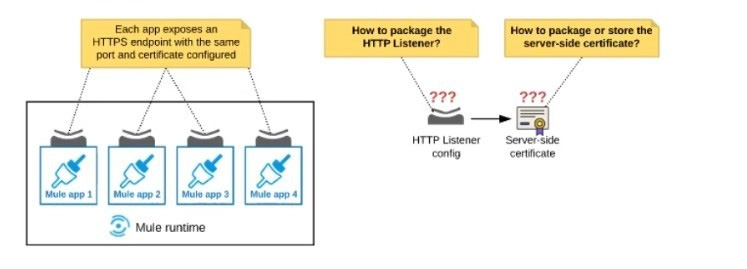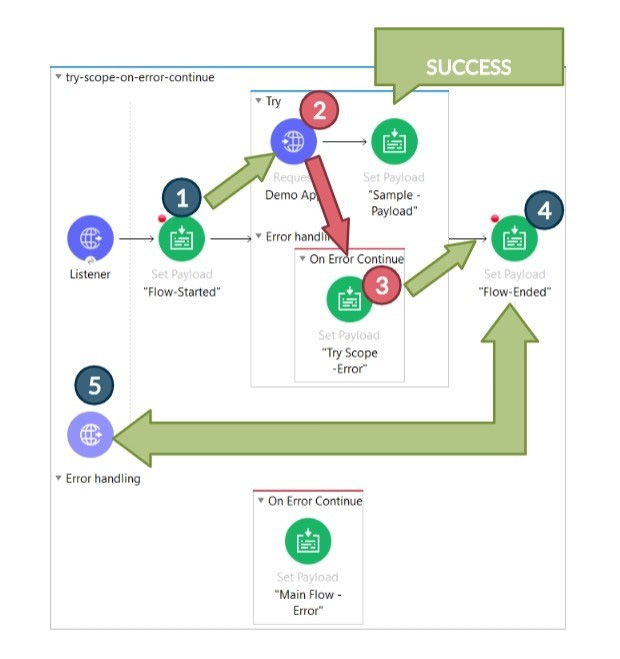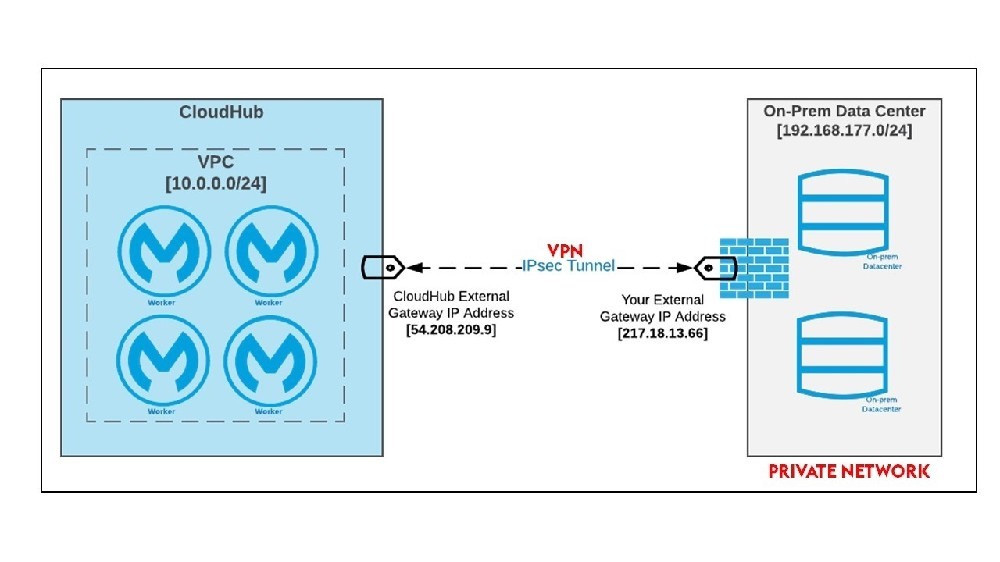Exam Details
Exam Code
:MCIA-LEVEL-1-MAINTENANCEExam Name
:MuleSoft Certified Integration Architect - Level 1 MAINTENANCECertification
:MuleSoft Certified ArchitectVendor
:MulesoftTotal Questions
:116 Q&AsLast Updated
:Jun 01, 2025
Mulesoft MuleSoft Certified Architect MCIA-LEVEL-1-MAINTENANCE Questions & Answers
-
Question 211:
An organization's governance process requires project teams to get formal approval from all key stakeholders for all new Integration design specifications. An integration Mule application Is being designed that interacts with various backend systems. The Mule application will be created using Anypoint Design Center or Anypoint Studio and will then be deployed to a customer-hosted runtime.
What key elements should be included in the integration design specification when requesting approval for this Mule application?
A. SLAs and non-functional requirements to access the backend systems
B. Snapshots of the Mule application's flows, including their error handling
C. A list of current and future consumers of the Mule application and their contact details
D. The credentials to access the backend systems and contact details for the administrator of each system
-
Question 212:
An integration Mute application consumes and processes a list of rows from a CSV file. Each row must be read from the CSV file, validated, and the row data sent to a JMS queue, in the exact order as in the CSV file.
If any processing step for a row falls, then a log entry must be written for that row, but processing of other rows must not be affected.
What combination of Mute components is most idiomatic (used according to their intended purpose) when Implementing the above requirements?
A. Scatter-Gather component On Error Continue scope
B. VM connector first Successful scope On Error Propagate scope
C. For Each scope On Error Continue scope
D. Async scope On Error Propagate scope
-
Question 213:
Which Anypoint Platform component should a MuleSoft developer use to create an API specification prior to building the API implementation?
A. MUnit
B. API Designer
C. API Manager
D. Runtime Manager
-
Question 214:
Mule applications need to be deployed to CloudHub so they can access on-premises database systems. These systems store sensitive and hence tightly protected data, so are not accessible over the internet.
What network architecture supports this requirement?
A. An Anypoint VPC connected to the on-premises network using an IPsec tunnel or AWS DirectConnect, plus matching firewall rules in the VPC and on-premises network
B. Static IP addresses for the Mule applications deployed to the CloudHub Shared Worker Cloud, plus matching firewall rules and IP whitelisting in the on-premises network
C. An Anypoint VPC with one Dedicated Load Balancer fronting each on-premises database system, plus matching IP whitelisting in the load balancer and firewall rules in the VPC and on-premises network
D. Relocation of the database systems to a DMZ in the on-premises network, with Mule applications deployed to the CloudHub Shared Worker Cloud connecting only to the DMZ
-
Question 215:
A mule application uses an HTTP request operation to involve an external API.
The external API follows the HTTP specification for proper status code usage.
What is possible cause when a 3xx status code is returned to the HTTP Request operation from the external API?
A. The request was not accepted by the external API
B. The request was Redirected to a different URL by the external API
C. The request was NOT RECEIVED by the external API
D. The request was ACCEPTED by the external API
-
Question 216:
An IT integration delivery team begins a project by gathering all of the requirements, and proceeds to execute the remaining project activities as sequential, non-repeating phases. Which IT project delivery methodology is this team following?
A. Kanban
B. Scrum
C. Waterfall
D. Agile
-
Question 217:
An organization is designing a Mule application to periodically poll an SFTP location for new files containing sales order records and then process those sales orders. Each sales order must be processed exactly once.
To support this requirement, the Mule application must identify and filter duplicate sales orders on the basis of a unique ID contained in each sales order record and then only send the new sales orders to the downstream system.
What is the most idiomatic (used for its intended purpose) Anypoint connector, validator, or scope that can be configured in the Mule application to filter duplicate sales orders on the basis of the unique ID field contained in each sales order
record?
A. Configure a Cache scope to filter and store each record from the received file by the order ID
B. Configure a Database connector to filter and store each record by the order ID
C. Configure an Idempotent Message Validator component to filter each record by the order ID
D. Configure a watermark In an On New or Updated File event source to filter unique records by the order ID
-
Question 218:
Customer has deployed mule applications to different customer hosted mule run times. Mule applications are managed from Anypoint platform.
What needs to be configured to monitor these Mule applications from Anypoint monitoring and what sends monitoring data to Anypoint monitoring?
A. Enable monitoring of individual applications from runtime manager application settings Runtime manager agent sends monitoring data from the mule applications to Anypoint monitoring
B. Install runtime manager agent on each mule runtime Runtime manager agent since monitoring data from the mule applications to Anypoint monitoring
C. Anypoint monitoring agent on each mule runtime Anypoint monitoring agent sends monitoring data from the mule applications to Anypoint monitoring
D. By default, Anypoint monitoring agent will be installed on each Mule run time Anypoint Monitoring agent automatically sends monitoring data from the Mule applications to Anypoint monitoring
-
Question 219:
Refer to the exhibit.

An organization deploys multiple Mule applications to the same customer -hosted Mule runtime. Many of these Mule applications must expose an HTTPS endpoint on the same port using a server-side certificate that rotates often.
What is the most effective way to package the HTTP Listener and package or store the server-side certificate when deploying these Mule applications, so the disruption caused by certificate rotation is minimized?
A. Package the HTTPS Listener configuration in a Mule DOMAIN project, referencing it from all Mule applications that need to expose an HTTPS endpoint Package the server- side certificate in ALL Mule APPLICATIONS that need to expose an HTTPS endpoint
B. Package the HTTPS Listener configuration in a Mule DOMAIN project, referencing it from all Mule applications that need to expose an HTTPS endpoint. Store the server-side certificate in a shared filesystem location in the Mule runtime's classpath, OUTSIDE the Mule DOMAIN or any Mule APPLICATION
C. Package an HTTPS Listener configuration In all Mule APPLICATIONS that need to expose an HTTPS endpoint Package the server-side certificate in a NEW Mule DOMAIN project
D. Package the HTTPS Listener configuration in a Mule DOMAIN project, referencing It from all Mule applications that need to expose an HTTPS endpoint. Package the server- side certificate in the SAME Mule DOMAIN project Go to Set
-
Question 220:
What Mule application can have API policies applied by Anypoint Platform to the endpoint exposed by that Mule application?
A. A Mule application that accepts requests over HTTP/1x
B. A Mule application that accepts JSON requests over TCP but is NOT required to provide a response.
C. A Mule application that accepts JSON requests over WebSocket
D. A Mule application that accepts gRPC requests over HTTP/2
Related Exams:
Tips on How to Prepare for the Exams
Nowadays, the certification exams become more and more important and required by more and more enterprises when applying for a job. But how to prepare for the exam effectively? How to prepare for the exam in a short time with less efforts? How to get a ideal result and how to find the most reliable resources? Here on Vcedump.com, you will find all the answers. Vcedump.com provide not only Mulesoft exam questions, answers and explanations but also complete assistance on your exam preparation and certification application. If you are confused on your MCIA-LEVEL-1-MAINTENANCE exam preparations and Mulesoft certification application, do not hesitate to visit our Vcedump.com to find your solutions here.


